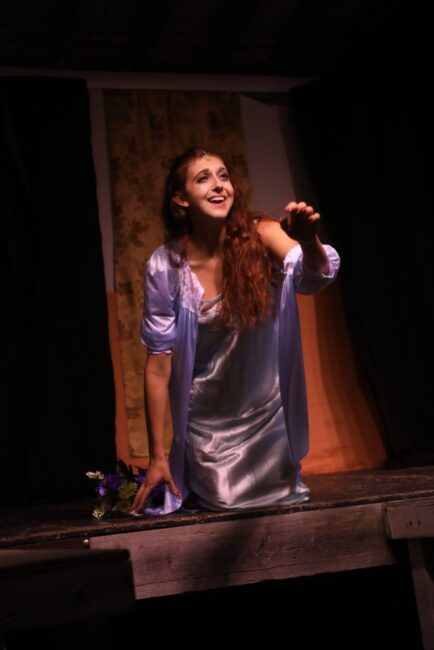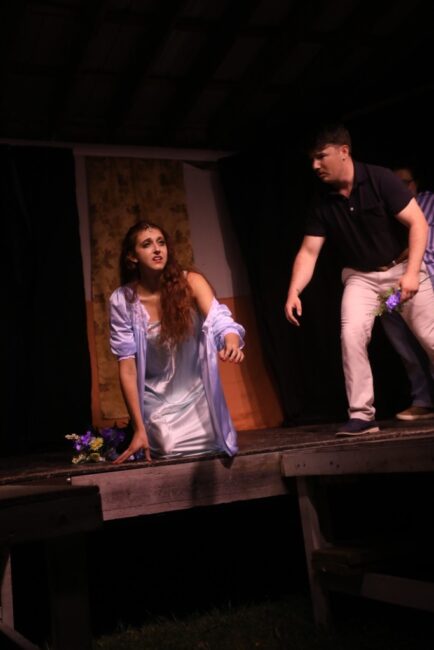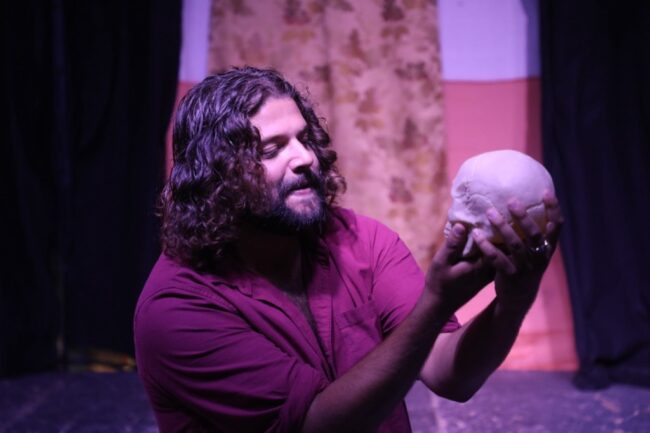To go or not to go? That is the question! Technically it’s ‘be’ or ‘not be’ but with Shakespeare being hundreds of years of dead, I’m sure he’ll grant us this liberal creative license…especially considering what the world at large is doing to his canon from a musical standpoint! I won’t extoll and wax poetic like Polonius, earning me an eyeroll from Laertes and Ophelia, no I shall to the point as brevity is the soul of wit. The Bard’s Wagon Players is up and rolling around— at least rolling to Reisterstown this summer season and they’re tackling that dramatic drama known as Hamlet. Directed by Deb Carson, the wagon is parking itself both in Hannah More Center & Park for a two-weekend run and in the ambiguously political 1960’s. Hey, Shakespeare’s dead, so you can set his stuff whenever and wherever you want.

It’s a college-try from this year’s band of merry makers. When one runs a wagon— which itself is quite the impressive feat, especially if you’ve never seen the thing close-up for the night (highly recommend sticking around through the end of the production to watch it ‘cloister itself’ for the evening)— on a shoestring budget, a passion for the arts, and a community sense of bringing Shakespeare in the park to Baltimore County, well the dreams and the aims are high. With the director and the cast coming together for all components of the production’s aesthetic and design, with the exception of sound and lighting (designed and ran by Bob and June Frank, the owners, operators and fabricators of the wagon itself), you get a polite hodgepodge of 1960’s esque ephemera, some of which works quite well.
Taking The Ghost King (as played with a hearty robustness by Bill Soucy) and putting him in the pressed white James Bond/John F. Kennedy white dinner jacket, giving him stifled almost animatronic moves as he ascends the ghostly platform so that Horatio and Hamlet can see his visage, was a clever choice. Just like Deb Carson’s removal of Ophelia from her dirt-hole-nap. (Spoiler, it’s a Shakespearean tragedy, nearly everybody dies by the end!) Having Polonius and The Ghost King ease her up to her feet and shuffle her off from the front of the wagon at the end of the scene is actually an ingenious way of showcasing not only is Ophelia ‘returned to the earth’ but it creates an effective visual, rather than just having the actor scoot, squirm, and frantically dash away to the ‘backstage.’ There are some truly terrific 60’s inspired pieces, particularly on the female characters like Gertrude (Erin Branigan) and even Ophelia herself before she hits her long silk robe of doom late in the second act— particularly the gloves and hats that are featured on Gertrude being the ones coming to mind. And there’s definitely some pants…and shoes…to be admired on both Rosencrantz and Guildenstern when it comes to the verve of the decade in which Carson has placed the show.
Outdoor theatre in Maryland presents hyper specific challenges, not the least of which is the weather, which for the moment seems to be fairing quite nicely. Bob and June Frank, some mic-balancing issues and overall sound-system issues (where you could hear scene-change music— era appropriate— but not coming through the speakers or the monitors) aside, do a decent job with the technical components of ‘theatre outdoors after dark.’ (At this performance the cicadas were in full roar until The Players arrived…perhaps Deb Carson lilting and prancing down the aisle intrigued them to silence as Carson was called upon to fill in for a felled cast member! At this performance the ice cream truck visiting the sports diamonds in the park decided to accompany the entire first act with its woebegone wailing tin-tune and nearly warranted itself a stabbing by Laertes’ envenomed foil-tip!)

Challenges and budgetary deficits aside, there were some pacing issues, but that might be chalked up to the fact that the company was down two performers with two last-minute, on-book fill-ins, though the show must go on and both Charles Dickinson and Deb Carson (jumping in for a whole slew of ensemble-style minor characters) gave admirable performances considering they were thrown into the breech with but a moment’s notice. Deb Carson renders the script so that instead of five acts and five hours and all that, we get something that, sluggish scene changes aside, runs about two hours and 30 minutes with the intermission. Though there were odd choices left in— particularly the ten-minute clown scene between the Grave Diggers (as played by Ken Berry and N. Kay Lenhart), which was unfortunately hard to hear as that was when the mics and the sound system really seemed to be acting up, (though thankfully by that point someone had slain the ice cream truck accompanist!)— for the most part, Carson made smart choices about what went where and truncating the show’s ending without all the treacle was truly a brilliant move on her part. (Shakespeare wrote himself his own perfect ending— twice over! First with Hamlet saying “…the rest is silence.” And then the lesser with Horatio and the “goodnight, sweet prince.” But then failed his own endings by adding all that nonsense with Horatio, Osric, Fortinbras, the ambassador, etc.)
Standout performances include the dynamic relationship between Laertes (Gage Wright) and sister Ophelia (Natalie Beller), particularly in their little teasing lead-up to Polonius’ entering and blathering on with all the famous quotes that get attributed to him, to thine own self be true, etc. Wright deeply embodies the incensed fury of the character later on in the performance and the slam-fight choreography between he and the titular character feels ramped up and looks authentic. (The sword fighting is slower, but clean in its marking and pacing.) Beller, who is the epitome of a twist-turned character, whose mind is being drive out of sorts by a man, delivers a brilliant series of moments peppered throughout the performance as well. It’s uncomfortable to watch her personalized descent into madness, her gaze is intense and hollow, her overall body language contorted with sorrow. Though the truly touching moment to watch— one that far too many of us can relate to— is during the “play within a play” wherein despite absorbing Hamlet’s emotional abuse, she welcomes him to rest his head in her lap, gently stroking his hair, and doting on him even though the jackass doesn’t deserve it, clearly signifying how he’s warped her mind with his head games. It’s a fascinating study in the way women through the centuries have been programed to respond to the men they feel drawn to. And Beller handles it beautifully.

Playing Polonius, Damien Gibbons gives the character a chucklesome lightheartedness not often seen in the elder-father figure. It’s neat to watch his facial expressions, particularly when he’s trying to discern what breed of madness is motivating the method of Hamlet’s mind. Gibbons also excels with his Scotch-Irish accent, featured momentarily when he becomes a boatsman (it’s literally three lines but it’s such a fine execution of said accent, it bore mentioning!)
You get a frat-bro camaraderie between Horatio (Molly Laska) and Hamlet (Benjamin Hopkins) and watching some of Laska’s facial expressions are also quite the entertainment during this performance. Hopkins provides a somewhat modern spin on the titular character, which to his credit isn’t entirely out of joint with the 1960’s semi-aesthetic approach to the show (1960’s verses when Hamlet was actually written and set is pretty modern) but does so with clean elocution and a surefooted understanding of Shakespearean dialect. There’s a particularly pleasing moment when he plops himself down in the audience— just shortly before his “words, words, words,” speech— and you find yourself getting an up-close-and-personal exposure to Hamlet’s madness. Hopkins is versatile and emotionally engaged, particularly when trying to juxtapose his frustrations against his sorrow against his high-shenanigans in an attempt to fake madness to the most noticeable max for those observing him.

Hopkins creates a profound moment in the ‘chapel’ scene with Claudius (Joshua Hopkins, who when he overreacts during the play within the play scene, you get quite the taste of his expressiveness) where he pontificates on the virtues of killing his Uncle-Father for vengeance but whether or not the moment of prayer is the right moment for it. (Of course, all of us scholars out here are thinking, “…if Hamlet had just been agnostic or atheistic, he could have slain Claudius then and there and saved us three acts, about a dozen more deaths, and then some!) Benjamin Hopkins also has intense moments with mother Gertrude (Erin Branigan, who to her credit takes up the pill-popping and excessive martini drinking in true 60’s political-figure-wife fashion!) during the closet scene, with Hopkins driving that scene with his furies, tempers, and wild execution of dialogue. The most intriguing scenes— aside from Hopkins’ asides, which are intensely addressed directly with this unyielding sense of smoldering ire in his eyes, right at the audience— for Hopkins are those he shares with Natalie Beller’s Ophelia, the aforementioned scene of the play within the play as well as when he confronts her about ‘the nunnery’ with Claudius and Polonius hiding nearby.
So let us sit we down, please let us speak of this again, good sirs, good madams, good gentle folk of the west side of Baltimore County. Tis a fine evening out, especially if it might be your first encounter with The Bard. Or The Bard’s Wagon Players. Hamlet has some truly brilliant moments, some nice aesthetic pieces, and a taste of Shakespearean tragedy for those wishing to sample such things this summer.
Running Time: Approximately 2 hours and 30 minutes with one intermission
Hamlet plays with The Bard’s Wagon Players, which is currently parking their wagon in Hannah More Center & Park— 12035 Reisterstown Road in Reisterstown, MD. Tickets are available upon arrival to the wagon…for advance reservations and more information, please call 443-929-8533.

